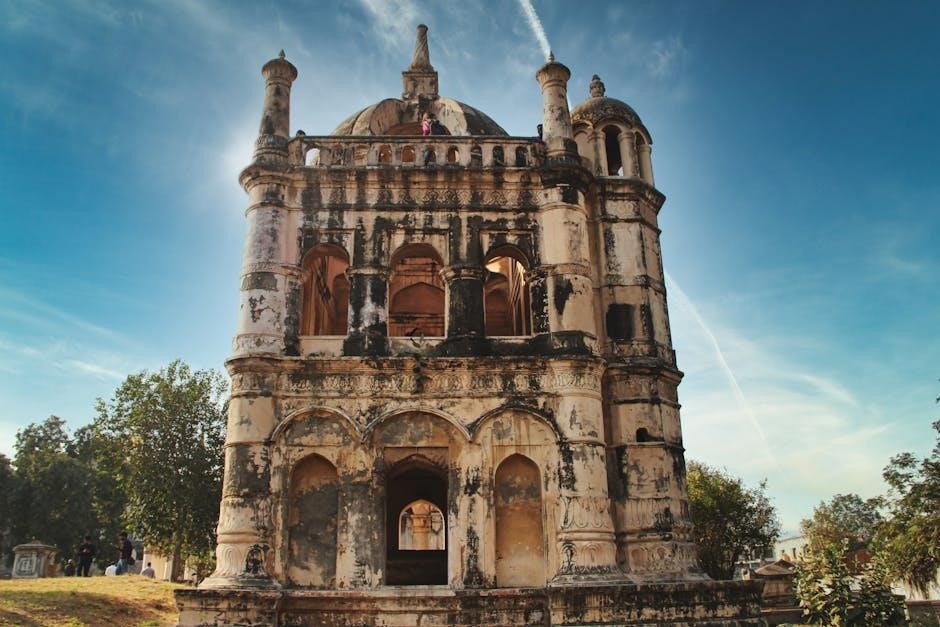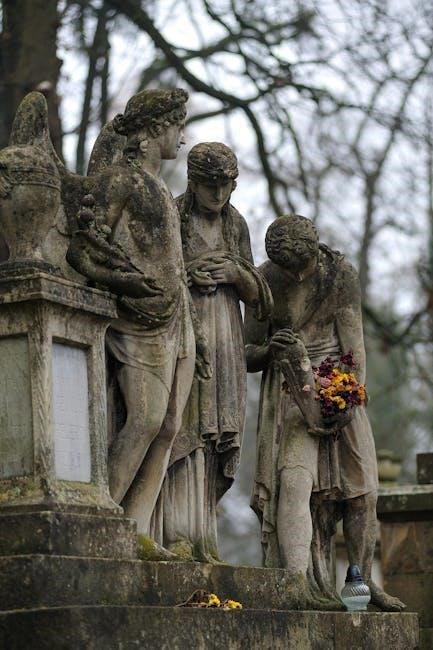Metairie Cemetery, established in 1872, is a historic New Orleans landmark known for its grand mausoleums and intricate tomb designs. A self-guided tour offers a fascinating glimpse into the city’s rich cultural heritage, blending history, art, and nature in a serene setting. Visitors can explore the grounds, discovering the final resting places of notable figures and marveling at the architectural beauty of the cemetery.
Historical Background
Metairie Cemetery, established in 1872, is a National Historic Landmark located in New Orleans, Louisiana. Originally the site of the Metairie Race Course, the grounds were transformed into a cemetery after the Civil War. The cemetery reflects the Victorian era’s grandeur and the city’s diverse cultural heritage. Its design was influenced by the rural cemetery movement, emphasizing beauty and tranquility. Notably, it was added to the National Register of Historic Places in 1975. Over the years, Metairie Cemetery has become a historic and artistic treasure, offering a serene escape from the bustling city while preserving the region’s rich history.

Notable Tombs and Memorials
Metairie Cemetery is renowned for its grand tombs and memorials, including the resting places of Confederate General P.G.T. Beauregard and jazz legend Al Hirt. The elaborate mausoleums, often designed in Greek and Roman styles, showcase the city’s rich history. The Besthoff family tomb, adorned with marble statues, is a particularly striking example of the cemetery’s artistic and historical significance.
Famous Residents
Metairie Cemetery is the final resting place of many notable figures, including jazz legend Al Hirt, known as “Jumbo,” and Confederate General P.G.T. Beauregard. The cemetery also houses the tomb of the Besthoff family, prominent in New Orleans’ pharmaceutical and cultural history. Other famous residents include Civil War veterans, influential businessmen, and artists who shaped the city’s vibrant culture. Their graves, often marked by elaborate mausoleums, reflect the rich history and diverse heritage of New Orleans. Exploring these sites during a self-guided tour offers a unique glimpse into the lives of those who contributed to the city’s enduring legacy.
Planning Your Self-Guided Tour
Download a map or guide to navigate the cemetery’s sprawling grounds. Plan your route to explore notable tombs and mausoleums, ensuring ample time for discovery. Wear comfortable shoes and bring water for a leisurely stroll. Respectful behavior is essential, maintaining silence and avoiding damage to graves. Consider visiting early or late for optimal lighting and fewer crowds. Bring a camera to capture the stunning architecture and serene atmosphere. Allow at least two hours to fully experience the cemetery’s historical and artistic treasures.
Preparing for Your Visit
Before visiting Metairie Cemetery, download a detailed map to plan your route. Wear comfortable walking shoes and bring water, as the grounds are extensive. Carry a camera to capture the stunning tombs and sculptures. Arrive early or late to avoid crowds and enjoy optimal lighting. Respect the cemetery’s rules: no drones, no loud noises, and no touching the graves. Bring sunscreen and a hat for sun protection. Allow at least two hours to explore thoroughly. Check the cemetery’s website for up-to-date hours and any specific guidelines. Prepare to immerse yourself in history, art, and nature in this unique setting.

Practical Tips for Visitors
Wear comfortable shoes for walking and bring water. Respect graves by not touching them. Use a map to navigate efficiently and avoid crowds by visiting weekdays.
Getting There and Parking
Metairie Cemetery is located at 5100 Pontchartrain Boulevard, New Orleans. Visitors can arrive by car, rideshare, or public transportation. The cemetery is accessible via major highways, making it convenient for travelers. Ample parking is available along the interior roads and near the entrance. Designated lots accommodate larger vehicles and provide easy access to the cemetery’s main pathways. Arriving early is recommended to secure parking, especially during peak visitation hours or weekends. The cemetery’s layout allows for easy navigation, and clear signage directs visitors to key areas. Parking is free, and the grounds are accessible for all vehicles.

Photography Opportunities
Metairie Cemetery offers stunning photography opportunities with its grand mausoleums, statues, and live oak trees. Seasonal blooms and historic above-ground tombs provide unique and captivating shots.
Best Spots for Photography
The cemetery’s main entrance, with its iconic arch, offers a dramatic first shot. The Besthoff Mausoleum, adorned with sculptures, and the nearby live oak trees draped in Spanish moss are must-captures. Seasonal blooms add vibrant colors, while the intricate tombs and statues provide endless artistic compositions. The grand mausoleums along Central Avenue and the serene lake with reflecting views create perfect backdrops for both wide-angle and close-up photography. Early morning or golden hour lighting enhances the beauty of the site, making it a photographer’s paradise for capturing history, art, and nature in harmony.
Cultural and Historical Significance
Metairie Cemetery, once a horse racetrack, became a burial ground in 1872, reflecting New Orleans’ history and cultural evolution. Its grand tombs honor Civil War veterans and notable figures, showcasing the city’s unique heritage and architectural legacy.
Role in New Orleans History
Metairie Cemetery played a pivotal role in New Orleans’ history, transitioning from a 19th-century horse racetrack to a burial ground in 1872. This shift reflected the city’s post-Civil War evolution and growing need for formal cemeteries. The cemetery became a final resting place for Civil War veterans, prominent businessmen, and civic leaders, embedding it in the region’s historical fabric. Its elaborate tombs and mausoleums mirror the city’s cultural diversity, blending Victorian, Gothic, and Neoclassical styles. Over time, Metairie Cemetery has endured as a testament to New Orleans’ resilience, surviving floods and hurricanes, including Katrina, while preserving its historical and cultural essence.
Nearby Attractions
Near Metairie Cemetery, visitors can explore City Park, home to the Besthoff Sculpture Garden and the New Orleans Museum of Art. Nearby historic sites and vibrant neighborhoods await.
Nearby Landmarks
Metairie Cemetery is conveniently located near several iconic New Orleans landmarks. City Park, spanning over 1,300 acres, offers the Besthoff Sculpture Garden and the New Orleans Museum of Art, showcasing stunning art and nature. The Lafitte Greenway, a 2.6-mile trail, provides a scenic route for biking or walking. Nearby, the historic Pontchartrain Hotel and the vibrant neighborhood of Uptown await exploration. These landmarks enhance the cultural and historical richness of the area, making Metairie Cemetery a great starting point for a comprehensive New Orleans experience.

Seasonal Events and Tours
Metairie Cemetery offers seasonal guided tours and special events, including historical reenactments and ghost tours, allowing visitors to explore its rich history and cultural significance.
Seasonal Events
Metairie Cemetery hosts a variety of seasonal events throughout the year, offering unique experiences for visitors. During Halloween, the cemetery comes alive with ghost tours and historical reenactments. In spring, flower-laying ceremonies honor the resting souls, while winter brings candlelight vigils. Guided tours are often scheduled during these seasons, providing deeper insights into the cemetery’s history and cultural significance. Special events may include lectures, art exhibits, or live performances, creating a connection between the past and present. Visitors are encouraged to check the cemetery’s schedule in advance to plan their visit around these engaging seasonal activities.
Visitor Etiquette
- Respect graves and memorials by not touching or damaging them.
- Maintain a quiet and reverent atmosphere while walking through the cemetery.
- Keep the grounds clean by disposing of trash properly.
- Stay on designated pathways to preserve the landscape.
- Follow all posted rules and guidelines during your visit.
Respecting Graves and Wildlife
Visitors are asked to treat Metairie Cemetery with reverence, ensuring no damage to graves or memorials. Avoid touching or climbing on tombs, as this can cause irreversible harm. Respect the wildlife by not feeding or disturbing animals, maintaining a peaceful environment. Stay on designated pathways to protect both the grounds and the wildlife. Keep the cemetery clean by disposing of trash properly. Photography is allowed for personal use, but avoid commercial shoots without permission. Silence or soft voices are appreciated to honor those interred and ensure a respectful atmosphere for all visitors. Adhere to all posted rules and guidelines during your visit.
Metairie Cemetery offers a unique and enriching self-guided tour experience, blending history, art, and nature. Visitors can explore the cemetery’s stunning architecture, pay respects to notable figures, and connect with New Orleans’ cultural legacy. Remember to approach the grounds with reverence, respecting graves, wildlife, and posted guidelines. Whether you’re drawn by history, photography, or personal reflection, Metairie Cemetery provides a memorable journey. Plan your visit thoughtfully, embrace the serene atmosphere, and leave with a deeper appreciation for this iconic landmark. Your self-guided tour promises to be both educational and emotionally rewarding, making it a must-visit destination in New Orleans.



